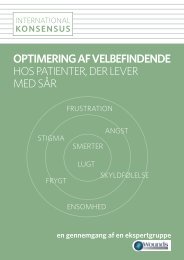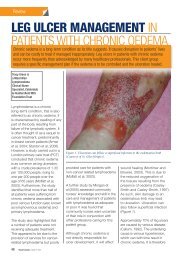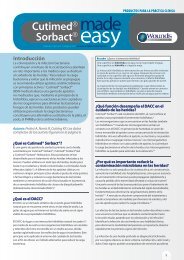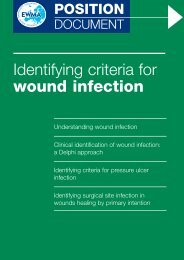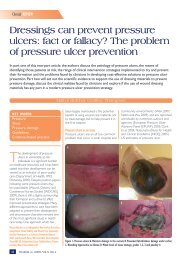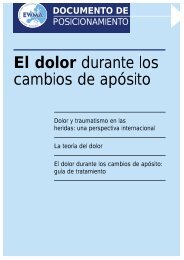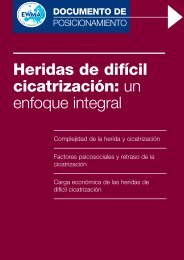document - EWMA
document - EWMA
document - EWMA
- No tags were found...
You also want an ePaper? Increase the reach of your titles
YUMPU automatically turns print PDFs into web optimized ePapers that Google loves.
DOCUMENTDE RÉFÉRENCELe site anatomique de la plaie, le contexte clinique (par ex. soins/maintien à domicile),l’aptitude du patient à tolérer le traitement, la disponibilité du personnel formé et del’équipement requis peuvent aussi signifier que l’usage de la TPN est inapproprié.Le tableau 1 fournit des commentaires utiles et des directives pratiques ayant trait auxcontre-indications et aux précautions indiquées par le fabricant.CONCLUSIONLa TPN doit être considérée de la même manière que les autres traitements des plaies : elledoit être choisie si elle représente la méthode la plus efficace cliniquement et la plus rentablepour atteindre les objectifs thérapeutiques définis. Les résultats du traitement doivent êtreréévalués en permanence. La TPN doit être considérée uniquement comme un composantimportant de la prise en charge globale des plaies : elle doit être introduite avec un objectifdéfini et une stratégie d’arrêt. Elle doit être interrompue quand les objectifs ont été atteints,quand le traitement ne satisfait pas les objectifs définis dans un délai acceptable ou quandelle n’est pas acceptée par le patient ou provoque des complications.Bibliographie1. Kamolz LP, Andel H, Haslik W, et al. Use of subatmospheric pressure therapy toprevent burn wound progression in human: first experiences. Burns 2004; 30(3):253-58.2. Vuerstaek JD, Vainas T, Wuite J, et al. State-of-the-art treatment of chronic legulcers: a randomized controlled trial comparing vacuum-assisted closure (V.A.C.)with modern wound dressing. J Vasc Surg 2006; 44(5): 1029-37.3. Armstrong DG, Lavery LA; Diabetic Foot Consortium. Negative pressure woundtherapy after partial diabetic foot amputation: a multicentre, randomisedcontrolled trial. Lancet 2005; 366(9498): 1704-10.4. Wild T, Stortecky S, Stremitzer S, et al. [Abdominal dressing - a new standard intherapy of the open abdomen following secondary peritonitis?] Zentralbl Chir2006; 131(Suppl 1): S111-14.5. Ford CN, Reinhard ER, Yeh D, et al. Interim analysis of a prospective, randomizedtrial of vacuum-assisted closure versus the Healthpoint system in themanagement of pressure ulcers. Ann Plast Surg 2002; 49(1): 55-61;discussion: 61.6. Jeschke MG, Rose C, Angele P, et al. Development of new reconstructivetechniques: use of Integra in combination with fibrin glue and negative-pressuretherapy for reconstruction of acute and chronic wounds. Plast Reconstr Surg2004; 113(2): 525-30.7. Sjögren J, Gustafsson R, Nilsson J, et al. Clinical outcome after poststernotomymediastinitis: vacuum-assisted closure versus conventional therapy. Ann ThoracSurg 2005; 79(6): 2049-55.8. Moues CM, Vos MC, van den Bemd GJ, et al. Bacterial load in relation tovacuum-assisted closure wound therapy: a prospective randomized trial. WoundRepair Regen 2004; 12(1): 11-17.9. Stannard JP, Robinson JT, Anderson ER, et al. Negative pressure wound therapyto treat hematomas and surgical incisions following high-energy trauma. J Trauma2006; 60(6): 1301-06.10. European Wound Management Association (<strong>EWMA</strong>). Position Document: Woundbed preparation in practice. London: MEP Ltd, 2004.11. Saxena V, Hwang CW, Huang S, et al. Vacuum-assisted closure:microdeformations of wounds and cell proliferation. Plast Reconstr Surg 2004;114(5): 1086-96; discussion 1097-98.12. Chen SZ, Li J, Li XY, et al. Effects of vacuum-assisted closure on woundmicrocirculation: an experimental study. Asian J Surg 2005; 28(3): 211-17.13. Wackenfors A, Sjögren J, Gustafsson R. Effects of vacuum-assisted closuretherapy on inguinal wound edge microvascular blood flow. Wound Repair Regen2004; 12(6): 600-06.14. Wackenfors A, Gustafsson R, Sjögren J, et al. Blood flow responses in theperisternal thoracic wall during vacuum-assisted closure therapy. Ann ThoracSurg 2005; 79(5): 1724-30; discussion 1730-31.15. Venturi ML, Attinger CE, Mesbahi AN, et al. Mechanisms and clinical applicationsof the vacuum-assisted closure (VAC) device: a review. Am J Clin Dermatol 2005;6(3): 185-94.16. Chester DL, Waters R. Adverse alteration of wound flora with topical negativepressuretherapy: a case report. Br J Plast Surg 2002; 55(6): 510-11.17. Morykwas MJ, Argenta LC, Shelton-Brown EI, et al. Vacuum-assisted closure: anew method for wound control and treatment: animal studies and basicfoundation. Ann Plast Surg 1997; 38(6): 553-62.18. Cowan KN, Teague L, Sue SC, et al. Vacuum-assisted wound closure of deepsternal infections in high-risk patients after cardiac surgery. Ann Thorac Surg2005; 80(6): 2205-12.19. Demaria R, Giovannini UM, Teot L, et al. Using VAC to treat a vascular bypass siteinfection. J Wound Care 2001; 10(2): 12-13.20. Schuster R, Moradzadeh A, Waxman K. The use of vacuum-assisted closuretherapy for the treatment of a large infected facial wound. Am Surg 2006; 72(2):129-31.21. Mehbod AA, Ogilvie JW, Pinto MR, et al. Postoperative deep wound infections inadults after spinal fusion: management with vacuum-assisted wound closure.J Spinal Disord Tech 2005; 18(1): 14-17.22. Dosluoglu HH, Schimpf DK, Schultz R, et al. Preservation of infected andexposed vascular grafts using vacuum assisted closure without muscle flapcoverage. J Vasc Surg 2005; 42(5): 989-92.23. Schimp VL, Worley C, Brunello S, et al. Vacuum-assisted closure in the treatmentof gynecologic oncology wound failures. Gynecol Oncol 2004; 92(2): 586-91.24. Scholl L, Chang E, Reitz B, et al. Sternal osteomyelitis: use of vacuum-assistedclosure device as an adjunct to definitive closure with sternectomy and muscleflap reconstruction. J Card Surg 2004; 19: 453-61.25. European Wound Management Association (<strong>EWMA</strong>). Position Document:Management of wound infection. London: MEP Ltd, 2006.26. Shi B, Chen SZ, Zhang P, et al. [Effects of vacuum-assisted closure (VAC) on theexpressions of MMP-1, 2, 13 in human granulation wound]. Zhonghua ZhengXing Wai Ke Za Zhi 2003; 19(4): 279-81.27. Banwell P, Téot L. Topical negative pressure (TNP): the evolution of a novel woundtherapy. J Tissue Viability 2006; 16(1): 16-24.28. Cro C, George KJ, Donnelly J, et al. Vacuum assisted closure system in themanagement of enterocutaneous fistulae. Postgrad Med J 2002; 78: 364-65.29. Goverman J, Yelon JA, Platz JJ, et al. The "Fistula VAC," a technique formanagement of enterocutaneous fistulae arising within the open abdomen: reportof 5 cases. J Trauma 2006; 60(2): 428-31; discussion 431.30. Brem H, Sheehan P, Rosenberg HJ, et al. Evidence-based protocol for diabeticfoot ulcers. Plast Reconstr Surg 2006; 117(7 Suppl); 193S-209S.31. Espensen EH, Nixon BP, Lavery LA, et al. Use of subatmospheric (VAC) therapyto improve bioengineered tissue grafting in diabetic foot wounds. J Am PodiatrMed Assoc 2002; 92(7): 395-97.32. Scherer LA, Shiver S, Chang M, et al. The vacuum assisted closure device: amethod of securing skin grafts and improving graft survival. Arch Surg 2002;137(8): 930-33; discussion 933-34.33. Yang CC, Chang DS, Webb LX. Vacuum-assisted closure for fasciotomy woundsfollowing compartment syndrome of the leg. J Surg Orthop Adv 2006; 15: 19-23.34. Heller L, Levin SL, Butler CE. Management of abdominal wound dehiscenceusing vacuum assisted closure in patients with compromised healing. Am J Surg2006; 191(2): 165-72.35. Hersh RE, Jack JM, Dahman MI, et al. The vacuum-assisted closure device as abridge to sternal wound closure. Ann Plast Surg 2001; 46(3): 250-54.36. Butter A, Emran M, Al-Jazaeri A, et al. Vacuum-assisted closure for woundmanagement in the pediatric population. J Pediatr Surg 2006; 41: 940-42.37. Gustafsson R, Johnsson P, Algotsson L, et al. Vacuum-assisted closure therapyguided by C-reactive protein level in patients with deep sternal wound infection.J Thorac Cardiovasc Surg 2002; 123(5): 895-900.38. Banwell P. V.A.C. ® Therapy TM Clinical Guidelines. A reference source for clinicians.KCI Ltd, September, 2005.39. Loree S, Dompmartin A, Penven K, et al. Is vacuum assisted closure a validtechnique for debriding chronic leg ulcers? J Wound Care 2004; 13(6): 249-52.40. Mandal A, Addison P, Stewart K, et al. Vacuum-assisted closure therapy inpyoderma gangrenosum. Eur J Plast Surg 2006; 28(8): 529-31.41. Ford-Dunn S. Use of vacuum assisted closure therapy in the palliation of amalignant wound. Palliat Med 2006; 20(40): 477-78.42. Kopp J, Strnad V, Bach AD, et al. Vacuum application increases therapeuticsafety and allows intensified local radiation treatment of malignant soft-tissuetumors. Strahlenther Onkol 2005; 181(2): 124-30.14




